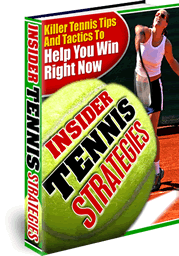 Ok, this post may not be for any younger players who still want to play every shot like Federer and be known as Rog the Second at the club.
Ok, this post may not be for any younger players who still want to play every shot like Federer and be known as Rog the Second at the club.But, if you've ever watched high level competition in the 55's and over, the game shifts from being a primarily physical battle to one of tactics, placement, endurance, and smarts.
The game is still physical, but you see less jumping on the groundstrokes ( if you see any), and less running around the backhand for example.
So, to get the conversation started, here is a link to the beginning of the 2011 US hardcourt finals in the men's 60 year old division.
The clip was posted on Youtube by Brent Abel, an ex-national champion, excellent instructor, and tennis entrepreneur.
Brent has posted tons of great free stuff on youtube.
This clip is the first of 3 of the men's 60 final. One of three interesting things is that the man who won, Larry Turville,was also the world's champion in the 60's in 2010. So, if you ever wanted to know what type of player can be a world champion in the super seniors, then study this tape.
There's so much to learn here and I'm going to use this match as the focus of my next few blog posts.
First of all, Larry Turville is 6 foot 8 inches tall! I don't know about your experiences, but at our club there is an elite player who is also 6 foot 8. Like Larry, he sort of moves in a way that looks slow, but covers the court in one step most of the time.
And, like Larry, his serve comes in from a different angle so seems to bounce higher than a serve from a shorter guy.
And, like Larry, you think there openings on the court, but then with one large step, the openings are covered.
But, I'm going to start with Larry's bread and butter shot -- the slice backhand. As Brent points out in the commentary, Larry's backhand is consistently extremely deep, landing within 12-18 inches of the baseline with regularity.
Most of the time he seems to go crosscourt and, it must be pointed out, that Larry is right handed and he was playing a righthander in the finals, so a crosscourt backhand would go to his opponent's backhand.
But, watch enough of the match and you'll see how Larry will hit a down the line slice that tails away from the court. So, after forcing his opponent into the backhand corner, Larry will then hit this up the line slice with sidespin that tails away. Even if his opponent can get to it, the odds are that he won't be able to do much with the ball, and Larry will really be set up to do some damage with the next ball.
It's a devastating pattern but one that must be executed with precision. If the down the slice veers to much to the center, then you would be giving your opponent an easy forehand --a cardinal mistake at almost any level.
That's lesson one --try and see if you can incorporate that pattern into your play.
Until next time,
Glenn Sheiner M.D. - author of Insider Tennis Strategies Champion Seniors Tennis Players guaranteed to make you a smarter tennis player and take your tennis to the next level. Also, check out the world's top tennis humor screensaver
Tennis Cartoon Screensaver. You can download a trial version for FREE.
Technorati Tags Tennis